When companies are faced with an economic shock, some of them tend to better prepared than others. The aim of the paper is to assess the effect of the financial/economic crisis on firm performance in Kazakhstan.
My research is focused on third largest industry by employment share in Kazakstan, which is Distribution sector [1]. I trace the survival status of more than 19000 grocery stores from 2017 till 2021 and examine the determinants of stores survival across periods of economic crisis. By applying the Cox proportional hazards model and OLS, I explore the effects of different variables like location, region, sales size, type of store regarded as key determinants of stores survival rate
Results of analysis showed that due to Covid-19 crisis, 1.8 times higher retail outlets closed in 2020 comparing to previous years and that rural outlets with high sales value has higher survival rates after Covid-19 crisis than urban outlets. In addition, I found out that traditional grocery outlets have higher survival rates than wholesale stores. This claim is supported by both non-parametric and parametric tests in the survival analysis.
From a normative perspective this finding could be important in softening the negative effects of crisis during recessions. Additionally, this research can act as guide for grocery stores as crisis management. There are very few research in this field in Kazakhstan and proposed thesis can help companies to choose their strategic directions in crisis management Kazakhstan.
Keywords: Firm failure, Effect of economic crises, Cox proportional hazards model, Kazakhstan, Survival Analysis, Survival Data, Covid-19 Crisis
Introduction
The last decade was very stressful for economic performance of Kazakhstan, with falling oil prices, with several steep devaluation of tenge and high inflation rate for many consecutive years. In this paper, I looked from the microeconomic perspective to the effect of this crisis to grocery stores. Such an approach helps also better to understand the importance of grocery stores characteristics for the macroeconomic performance of Kazakhstan. In order to find out how to grow the economics, I tried to find out what types of characteristics of outlets increase their probability of survival from crisis. It is well known that firms that successfully adapt to market fluctuations makes better off than during crisis.
I plan to contribute to the literature in the following respects. First, research will be on Kazakhstan. There is no survival analysis of firms yet on Kazakhstan. Second, survival analysis will be conducted on Covid-19 crisis and will be actual and on current interest. Since, Covid-19 crisis has many differences comparing to previous recessions.
Literature Review
There is now a lot of interesting researches available in this field. Studies showed that differences in ownership and corporate hierarchy have huge effect on firm performance [2]. More specifically, typical characteristics of surviving firms outsider ownership that includes foreigners and an independent board of directors are suggested as typical characteristics of surviving firms. Firm size and age also matter for firm survival. Large firms are less likely to fail, whereas the effect of firm age is nonlinear [3]. In addition, there is evidence that the orientation of firms affects their survival. Firms oriented toward innovation, export, and diversification survive longer than those that are not [4].
Another research conducted by Mitton (2002) on East Asian financial crisis of 1997–1998 in countries like Korea, Philippines, Malaysia and Thailand revealed that firms that are more concentrated on less product or services rather than other firms with diversified portfolio or services performed better during recession [5]. Firms that have bid amount of credits or affiliation with conglomerates have higher probability to fail during the crisis period [6]. In addition, firms that has board of managers (or several people in charge) has higher chance to fail than firms lead by independent owners or managers [7].
Another survival analysis conducted in Croatia showed that firms with long term investments prior to crisis has between 60 and 70 % higher survival rates than similar firms that chose not to invest [8]. Another survival analysis conducted in Russia found out that companies which consult with international audit firm increases their probability of firm survival [9].
Data collection and research methodology
Data that I used in this project are collected from tobacco company “Japan Tobacco International” (JTI) sales to outlets. JTI’s distributor has more than 30,000 outlets coverage in Kazakhstan and has detailed sales data to for each outlet on daily basis. But I used only data for 19,466 traditional outlets (convenience shops) that are covered by JTI’s internal sales representatives, excluding modern trade and key account sales. Data used in research are from 2017 and survival analysis period starts from March 2020, period when Covid-19 quarantine started in Kazakhstan.
The main component in the standard survival analysis is failure event. In my research failure is when grocery stores close their store or quit from the business. Another important parameter is total time past until the failure. In my case this is number of months which the grocery stores were continuing their operations. Using our panel data, I estimate the survival functions and hazard rates for our specified variables (nonparametric methods). Then I apply Cox proportional hazard model (parametric method) to estimate the survival rates for different factors of grocery stores.
Analysis and Findings
JTI has the highest market share % in Kazakhstan with more than 40 % share. In addition, JTI’s Distributor company called “Megapolis” also delivers the cigarettes of second highest tobacco company in Kazakhstan — “Philip Morris International”. So basically, distributor company “Megapolis” covers more than 70 % of volume of cigarettes in Kazakhstan. In addition, cigarettes are one of the best selling product in traditional outlets making highest share of grocery store’s turnover. It means that if outlet do not buy cigarettes of JTI at all for several consecutive months, I assume that it is closed. So using JTI direct sales data to outlets, I can anticipate the number of closed outlets and conduct survival analysis.
Note: All the graph is prepared by author using data from JTI sales to outlets for 2020 and shows smoothed hazard rate for all 19,466 outlets.
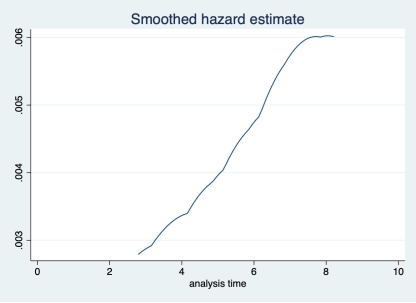
Fig. 1. Hazard rate for all outlets February to December 2020
In Figure 1, smoothed hazard estimate for 19,466 outlets show outlets started to close after 3 rd -4 th months and incresing in the same phase till 8 th month, meaning that outlets started to close in June-July 2020 and had peak of closing on October-November 2020
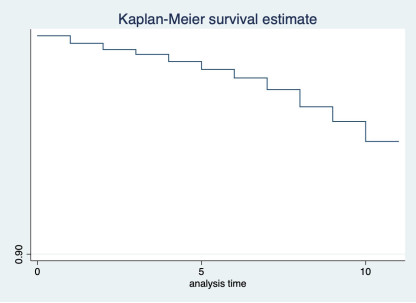
Fig. 2. Kaplan-Meier survivor function of all outlets survival probability
In Figure 2, we can see that 4.8 % of outlets from 19,466 outlets analyzed in research have closed after Covid19 in 2020. If we compare the failure % with previous years, failure % in 2020 in average 77 % higher than 2019 and 2018. It means that higher failure rate of grocery stores in Kazakhstan can be the result of Covid-19 crisis.
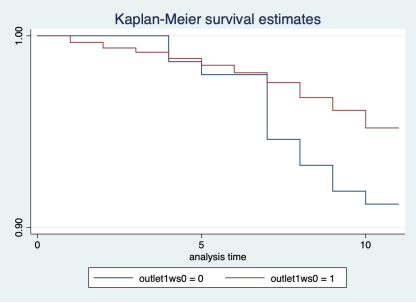
Fig. 3. Kaplan-Meier survivor function of all outlets survival probability by type of outlets
As it is shown in Figure 3 above, % share of outlets closed in 2020 in wholesale type of outlets is about twice higher than in traditional outlets. Failure % in wholesale is 8.7 % and in regular outlet groups is 4.8 %. But in addition, we should consider that numeric coverage of 148 Wholesale outlets out of 19,466 outlets less than 1 % of numeric coverage, but making bigger contribution in weighted coverage.

Fig. 4. Kaplan-Meier survivor function of all outlets survival probability by type of location (urban or rural)
Figure 5 shows that urban outlets failure % = 5.2 % is slightly higher that in rural = 4.1 %. In addition, the distribution of urban/rural is: 34.67 % of coverage located in rural areas and 65.33 % in urban areas.
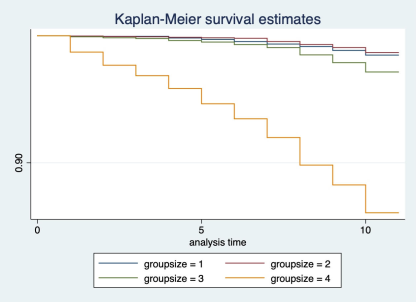
Fig. 5. Kaplan-Meier survivor function of all outlets survival probability by size of sales groups
Table 1
Distribution of outlets and failure % by size of sales groups
|
Group by sales size |
Sales range |
Share % |
Failure % |
|
Group Size 1 |
above 125 cartons |
23.63 % |
1.52 % |
|
Group Size 2 |
80 to 124 cartons |
26.06 % |
1.32 % |
|
Group Size 3 |
50 to 79 cartons |
25.95 % |
2.86 % |
|
Group Size 4 |
below 50 cartons |
24.37 % |
13.90 % |
From the Figure 6 and Table 1 we can see that most outlets that have been closed have smallest size of sales. Sales range where chosen to evenly distribute all into 4 groups. Stores that buy less than 50 cartons per month considered as lowest category stores and we can see that 13.90 % of outlets which has less than 50 cartons of sales per month in average have closed after Covid19. One of my assumptions why possibly the smallest sales size stores closed after Covid19 that other bigger stores, is that they couldn’t cover all the cost in outlet with decreasing profit after crisis.
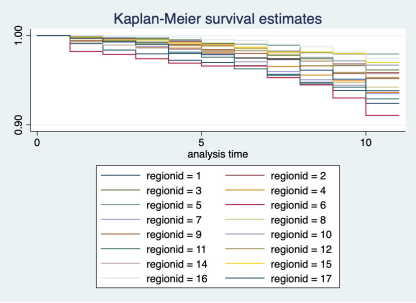
Fig. 6. Kaplan-Meier survivor function of all outlets survival probability by region
Table 2
Distribution of outlets and failure % by regions
|
Region |
Region ID |
Failure % |
Number of outlets |
Share % |
|
Nur-Sultan |
1 |
7.60 % |
1 659 |
8.52 % |
|
Almaty |
2 |
4.16 % |
4 084 |
20.98 % |
|
Akmola |
3 |
3.85 % |
1 038 |
5.33 % |
|
Aktobe |
4 |
6.37 % |
926 |
4.76 % |
|
Taldykorgan |
5 |
2.07 % |
725 |
3.72 % |
|
Atyrau |
6 |
8.94 % |
615 |
3.16 % |
|
West Kazakhstan |
7 |
6.50 % |
646 |
3.32 % |
|
Zhambyl |
8 |
5.78 % |
813 |
4.18 % |
|
Karaganda |
9 |
4.82 % |
1 597 |
8.20 % |
|
Kostanay |
10 |
3.30 % |
1 269 |
6.52 % |
|
Kyzylorda |
11 |
7.08 % |
536 |
2.75 % |
|
Mangystau |
12 |
4.68 % |
704 |
3.62 % |
|
Pavlodar |
14 |
4.28 % |
1 214 |
6.24 % |
|
North Kazakhstan |
15 |
3.02 % |
597 |
3.07 % |
|
East Kazakhstan |
16 |
2.54 % |
1 652 |
8.49 % |
|
Shymkent |
17 |
6.18 % |
1 391 |
7.15 % |
From the Figure 6 and Table 2 we can see that in Nur-sultan 7.6 %, South region 6.7 % in average and in West region 6.5 %, survival failure % of outlets is higher than national average. The reason behind this numbers can be that in Nur-sultan, the rules and control from government of quarantine regime is higher and possibly it affected on failure of 7.6 % of outlets. South region has highest number of outlets per capita and after Covid-19, most of them closed due to the type of outlets. Most of outlets in south region are opened in the houses or apartment of owners. West region’s high survival failure % can be explained by closing of oil production plants by decreasing of number of potential buyers.
Table 3
Cox proportional hazard model for sales group, region, type of outlet (wholesale/outlet), location (urban/rural) and target group
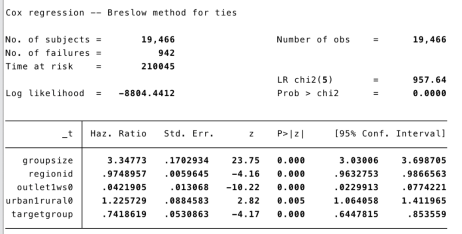
Table 4
OLS Regression model of sales volumes to region, type of outlet (wholesale/outlet), location (urban/rural) and target group
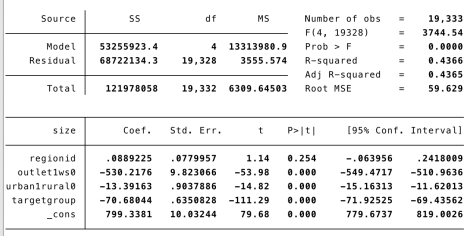
Note: The OLS Regression model is prepared by author in STATA by using data from JTI sales to outlets for 2020.
Cox regression model and OLS regression model results have showed that region is less affected factor to the size of sales of outlets (p-value 0.254). Other factors like urban/rural, wholesale/regular outlet, target group has very high effect on the sales volume of outlet, as the P value for all of them are about 0.000
Conclusions
In conclusion, we can see that Covid-19 crisis had definitely affected the survival rate of outlets in Kazakhstan. Also research has shown that wholesale outlets, urban outlets and outlets with small sales had affected most by crisis. In addition, we found regions in Kazakhstan where Covid-19 crisis had higher effect on survival of outlets. To test other hypothesis, I need data described in shortcomings of research. Of course, this research have limitations. Since there can be different factors which might also affected on higher failure rates of grocery stores in Kazakhstan after Covid19: Number of new modern trade stores opened after Covid19, emerging market of e-commerce in Kazahstan etc.
References:
- Bijnens, G., & Konings, J. (2018). An enterprise map of Kazakhstan: a guide for industrial policy. June, 1–35.
- Mata, J., and Portugal, P. (1994), Life Duration of New Firms, Journal of Industrial Economics, 42(5): 227–245.
- Dunne, J., and Hughes, A. (1994), Age, Size, Growth and Survival: UK Companies in the 1980s,Journal of Industrial Economics, 42(2): 115–140.
- Commander, S., and Svjenar, J. (2011), Business Environment, Exports, Ownership, and Firm Performance, Review of Economics and Statistics, 93(1): 309–337.
- Mitton, T. (2002), A Cross-firm Analysis of the Impact of Corporate Governance on the East Asian
- Baek, J-S., Kang, J.-K., and Park, K. (2004), Corporate Governance and Firm Value: Evidence from the Korean Financial Crisis, Journal of Financial Economics, 71: 265–313.
- Kang, J.-K., Lee, I., and Na, H, (2010), Economic Shock, Owner-manager Incentives, and Corporate Restructuring: Evidence from the Financial Crisis in Korea, Journal of Corporate Finance, 16: 335–351.
- Kovac, D., Vukovic, V., Kleut, N., & Podobnik, B. (2016). To invest or not to invest, that is the question: Analysis of firm behavior under anticipated shocks. PLoS ONE, 11(8), 1–18. https://doi.org/10.1371/journal.pone.0158782
- Iwasaki, I., & Kim, B.-Y. (2018). Firm failure in Russia during economic crises and growth : A large survival analysis. RRC Working Paper Series No. 76, 7.

